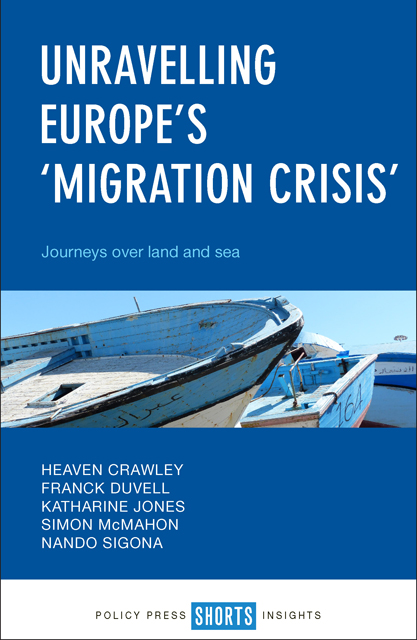Book contents
- Frontmatter
- Contents
- List of figures
- List of boxes
- Acronyms
- Notes on the authors
- Acknowledgements
- Foreword by Joanne Liu
- one The view from Europe
- two Unravelling Europe’s ‘migration crisis’
- three Not one route but many: unpacking migration to Europe
- four The decision to leave
- five Navigating borders and danger: the use of smugglers
- six Moving on
- seven Across the sea… and beyond
- eight Rethinking Europe’s response
- References
- Index
two - Unravelling Europe’s ‘migration crisis’
Published online by Cambridge University Press: 21 April 2023
- Frontmatter
- Contents
- List of figures
- List of boxes
- Acronyms
- Notes on the authors
- Acknowledgements
- Foreword by Joanne Liu
- one The view from Europe
- two Unravelling Europe’s ‘migration crisis’
- three Not one route but many: unpacking migration to Europe
- four The decision to leave
- five Navigating borders and danger: the use of smugglers
- six Moving on
- seven Across the sea… and beyond
- eight Rethinking Europe’s response
- References
- Index
Summary
Before unpacking the journeys of the refugees and migrants with whom we spoke, we need to first situate the ‘migration crisis’ within its wider geographical and historical context. This is important because it suggests that the ‘crisis’ was neither singular in the way that it unfolded at the EU southern borders, nor one of numbers per se. Migration across the Mediterranean was not new and irregular boat crossings, particularly along the Central and Western Mediterranean routes,1 have attracted attention since the 1990s. Neither should the rise in sea arrivals have been unexpected given events that had been unfolding in the region since 2011, most notably in Libya and Syria. However, while Italy had put in place a set of urgency measures since 2011, Greece was unprepared for the rapid and sudden increase in spontaneous sea arrivals. The failure to provide appropriate reception facilities for refugees and migrants arriving in increasingly large numbers in the summer of 2015 led to chaotic scenes on the Greek islands, a humanitarian crisis unlike that seen previously and an overwhelming sense that the situation was ‘out of control’. This perception was exacerbated by dramatic images of tens of thousands of people moving onwards through Europe.
Mediterranean migration in global and historical context
Migration across the Mediterranean generated endless media coverage and political discussion during 2015. Yet, arrivals were not particularly large when compared with migratory flows in other regions of the world, or even migration into and across Europe at other times in history.
First, migration to Europe has to be understood in the context of global migration flows. Although the percentage of the world’s population living outside their country of origin has not changed significantly in the last few decades, the number of international migrants has increased by 41% since 2000, in part due to the rapid increase in the world’s population (UN, 2015a). Globally, employment and family reunification remain the main reasons for migration but conflict, persecution and human rights abuse has also forced more people to leave their homes than ever before. By the end of 2015 more than 65 million people were displaced worldwide, one third of whom (21.3 million) were refugees living outside their countries of origin (UNHCR, 2016): the remainder were internally displaced. What is important is that the scale of displacement accelerated during the course of 2015 with an estimated 12.
- Type
- Chapter
- Information
- Unravelling Europe's 'Migration Crisis'Journeys Over Land and Sea, pp. 13 - 28Publisher: Bristol University PressPrint publication year: 2017



